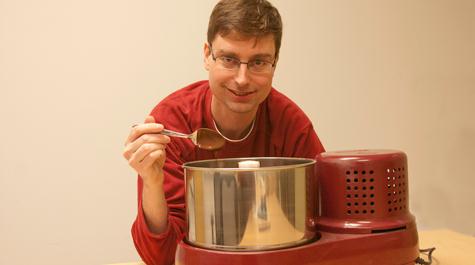Dark matter by day, dark chocolate by night
Joshua Erlich is a theoretical physicist. He spends his days pondering the mysteries of dark matter.
Many physicists believe that dark matter comprises most of the stuff of the universe, but Erlich can’t prove that dark matter even exists. Dark chocolate is another matter. He has complete control over dark chocolate. He makes it in his kitchen, starting with the cocoa beans, and also produces milk chocolate and various flavored chocolates.
Anyone who has bitten the ears off a foil-wrapped bunny knows that all chocolate is not created equal. Erlich, an associate professor of physics at William & Mary, says it’s easy to explain the difference between rich, velvety, to-die-for chocolate and the thin-tasting, crumbly, not-worth-the-calories stuff. It’s all scientific.
“The physical properties determine a lot of the qualities of taste, of feel—the mouth-feel—of the chocolate,” he said. “There’s a lot of physics that goes into the preparation of chocolate and into the properties we experience when we eat chocolate.”
The most important variable when it comes to chocolate quality, he says, is the crystal structure. Erlich has given his Science of Chocolate presentation at a number of meetings, including area schools and at his department’s PhysicsFest outreach programs. In casual hallway conversations or in front of an auditorium of science buffs, Erlich likes to explain the crystal structures of chocolate by comparing them with the crystal structures of carbon.
“Carbon forms different types of crystal structures; it’s a polymorphic crystal that can come in different crystal types,” he said. “The most stable is graphite—pencil lead. It’s not the hardest. The hardest is diamond; it’s also pure carbon. But there’s many other forms of carbon.”
Crystal structure—the three-dimensional assembly of the atoms and molecules in a compound—dictates the properties of the compound. Just as crystal structure dictates whether the piece of carbon in your hand is pencil lead, coal or diamond, the crystal structure of any particular piece of chocolate has a lot to do with where that piece lands on the meh-to-yum scale.
Erlich explained that the quality-minded, scientific chocolate maker’s goal is to produce a chocolate that has the most stable crystal structure. It’s practical for the hobbyist cocoa buff to produce five of chocolate’s six crystal structures.
“The goal is called type 5,” he said. “It’s not the most stable—but it’s the next to most stable. You can make it in the lab or on your countertop.”
You get to type 5 through a process called tempering, Erlich explains. Tempering comes at the end of the chocolate-making process. First comes the roasting of the beans and a minimum of 12 hours of grinding them, along with additives such as sugar or any flavorings such as hazelnut oil or vanilla. If you’re making milk chocolate, now’s the time to add the milk, he added.
“You’re left with something with particles fine enough that you don’t feel them at the top of your mouth while you’re eating the chocolate,” he explained. “The chocolate particles should be about 20 microns in order for you to not feel grittiness.”
When the cocoa reaches this point, the chocolate maker should be thinking about tempering. Not surprisingly, there’s a lot of physics involved in tempering.
“When one tempers chocolate, what one’s doing is trying to make as much of the chocolate crystal in the batch,” he said. “It’s very similar to what one would do when trying to grow a certain kind of crystal. Luckily, the most the most stable chocolate crystal structure melts at the highest temperature.”
He explains that to temper chocolate, you melt all of the particles so you get liquid chocolate. Then you start forming all of the different crystal structures by agitating some of the chocolate on a cold surface. You put that working batch back into a larger batch of chocolate, then hold that larger batch at the right temperature. The right temperature, he says, is between the temperature at which the most stable crystal structure melts and the next most stable crystal structure melts.
“And if you just wait a little while,” he says, “you’re left with mostly type 5 chocolate crystals. That’s what makes a good ‘snap’ when you bit into it.”
The snap is diagnostic to good chocolate, as is its workability. Erlich says that you can bang good quality dark chocolate cleanly out of a mold. Milk and other additives make chocolate hard to work with, he said, even though the additives don’t affect the crystal structure.
Working with chocolate leaves plenty of room for experimentation. Erlich says that there is an interesting variation among the beans, much like coffees and grapes.
“Beans from different locations have different tastes, different flavor profiles,” he said. “One can easily become a connoisseur of chocolate the same way one becomes a connoisseur of wine.”
Erlich says that among the benefits of chocolate making is that the hobby enjoys the full and enthusiastic support of his wife, Veronica. Chocolate making only becomes a problem in early February, when the thoughts of all men turn slowly toward the knotty problem of the Valentine’s Day gift.
“I can’t do chocolate,” he said. “because if I give anything related to chocolate to my wife she thinks I’m really giving it secretly to myself. And she’s correct. So nothing related to chocolate will work as a gift anymore.”
 Skip to main content
Skip to main content


